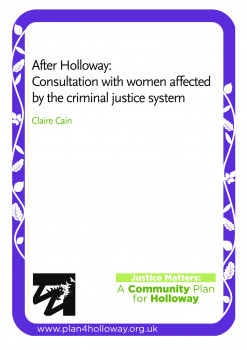After Holloway: Consultation with women affected by the criminal justice system
This new report, from Women in Prison and the Centre for Crime and Justice Studies, finds that the closure of the prison in 2016, caused significant distress and anxiety among prisoners and led to many women being imprisoned further away from home, hindering visits from family and children.

The closure of HMP Holloway - the only women’s prison in London and largest in Western Europe is continuing to have a negative impact on the rest of the women’s prison estate including being raised during a recent inquest as a possible factor in the death of a woman who died in HMP Drake Hall a few months after Holloway’s closure.
In the UK there is a chronic overuse of imprisonment with 84% of women sentenced to prison for a non-violent crime on a short sentence, often for theft such as shoplifting. One in four women sentenced to prison last year were sentenced to one month or less. Most women in prison have experience of domestic or sexual violence, are battling addiction, serious mental ill-health or are homeless and living in poverty. A third of women in prison grew up in care. It is these issues that are the root cause of offending.
The report points out that the best way to reduce crime is through community support and housing which enables women to address the root causes of offending and away from the additional harm caused by imprisonment.
The charity, Women in Prison, with support from the local planning authority, Islington Council,is calling for any redevelopment of the site to include housing that is genuinely affordable and investment in community support services for women. The key demand is for a Women’s Building to be built, an idea inspired by the closure and redevelopment of a woman’s prison in New York - a hub to host multiple women’s support services and to promote women’s empowerment and justice.
Dr Kate Paradine, Women in Prison’s Chief Executive says:
Holloway was closed without consultation with either the women directly affected or charities, such as Women in Prison, delivering services there. Despite this we, and many others, hoped that the decision signalled a change in public policy to focus on radically reducing the prison population and moving away from prison to community alternatives. Sadly, the reality could not be further from the truth. As our report After Holloway shows the rushed and ill-thought out closure of Holloway led to a lot of anxiety and distress for women in prison and continues to have a negative impact as women are imprisoned further from their families and home communities.
The closure of Holloway caused a ripple across the prison estate with an increase in numbers of women coming into the other prisons with high complex needs and rooms doubling up - resulting in more noise and chaos. For the first three months that women were moved to the re-opened Downview the prison was not yet fully up and running with very little activities and support services in place.
The year of Holloway’s closure, 2016, saw the highest number of deaths in the women’s prison estate on record. Two years later and prison governors and staff have worked hard to recover from the closure. HMP Downview, for instance, offers activities, education and healthcare on a greater scale. However, the whole experience of the closure has shown that women in prison are still completely invisible. They have been pushed further out of sight, and continue to be harmed by the criminal justice system.
Holloway’s closure has so far proved to be a deeply harmful process. But we believe this can still change and lead to a great social justice victory. We hope the calls from women in the report for the land to be used for genuinely affordable housing and women’s support services are heard.
With the redevelopment of Holloway and the Ministry of Justice due to publish its Women’s Justice Strategy setting out the vision for women and the criminal justice system for the next 5-10 years we have a golden opportunity to choose social justice, , and the empowerment of communities so that the site is used to demonstrate what a different system could look like: Where communities hold the answer to issues faced by women with complex needs and those who offend – not prisons.
Richard Garside, Director of the Centre for Crime and Justice Studies, says:
The closure of Holloway was botched and I hope the government has learned the lessons from this. The closure has also ignited a campaign – Community Plan for Holloway – aimed at achieving a positive legacy: a redeveloped site guided by the needs and aspirations of the local population.
The momentum behind this campaign highlights the potential for the positive redevelopment of former prison sites, using the land to promote human flourishing, rather than punishment and exclusion.
Key findings from interviews held with women affected by the criminal justice system in After Holloway (p4-5):
- The closure of Holloway had, and continues to have, a significant negative impact on women affected by the criminal justice system.
- The redevelopment of the Holloway site should include specialist housing for women affected by the criminal justice system.
- Support services for mental health and domestic violence were identified by participants as a key need to be developed on the site.
- The Holloway site should be used to support and empower women.
- The redevelopment should acknowledge that the site was a prison of historical significance.